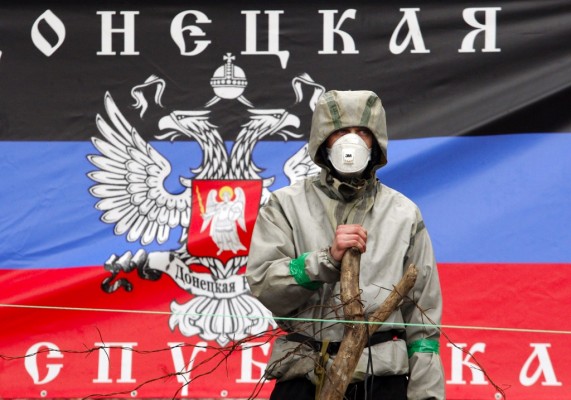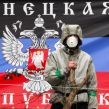
Russia Takes Breathing Pause From Military Hostilities in Ukraine
Publication: Eurasia Daily Monitor Volume: 11 Issue: 222
By:

Russia seems about to suspend the military phase of its multi-dimensional assault on Ukraine. The Kremlin’s “Novorossiya” project (see EDM, May 27) is shelved until further notice. Instead, Moscow is switching to what Foreign Affairs Minister Sergei Lavrov has termed “a post-war phase, so to speak” (RIA Novosti, December 9).
Since December 9, the intensity level of Russian and proxy attacks on Ukrainian positions in Donbas (eastern Ukrainian area encompassing Donetsk and Luhansk provinces) has markedly subsided. On that date, a “silence regime” (informally agreed ceasefire) went into effect (Sprotyv.info, December 9–11), coordinated in the field by senior representatives of the Ukrainian and Russian general staffs. It is plausibly surmised (although no evidence has surfaced in the public domain) that the Ukrainian and Russian presidential administrations have coordinated to instruct their respective general staffs to introduce the silence regime.
According to Ukrainian General Staff estimates, Russian troops in Donbas currently total 32,000, including between 6,000 and 10,000 regular Russian Army personnel, the remainder being irregulars recruited locally and from Russia (Ukrinform, December 11). The September armistice agreements had ended full-scale hostilities, but only to mark a transition to positional warfare. The Russian side continually attacked Ukrainian positions, attempting in vain to capture logistical hubs or otherwise to shift the demarcation line (see below). If the silence regime introduced on December 9 holds, it would mark a second transition—from positional warfare to “freezing” the military conflict. This corresponds with a freeze on the diplomatic process (see accompanying article).
Moscow’s shift reflects, on one hand, a recognition that it has exhausted the opportunities for the overt use of force against Ukraine at this time. On the other hand it reflects Russia’s priority goal to consolidate the gains achieved thus far, as a basis to any further course of action against Ukraine, contingent on opportunities.
After three months of continually breaching the ceasefire, Russian and proxy forces have failed to expand beyond the ceasefire lines. Ukrainian forces have successfully defended the Donetsk airport, Debaltseve salient, and other positions under attack on the line of contact. The Ukrainians have also blocked Russian probing moves on Mariupol and the land route toward the Russian-annexed Crimea.
Winter, in any case, imposes a halt to offensive operations. Any further Russian advance would require a full-scale use of heavy conventional forces, at a prohibitive cost in terms of new Western sanctions on Russia. Falling oil and gas prices would exacerbate the impact of new sanctions in that case. Moscow must also realize that continuing military attacks can only contribute to the political consolidation of Ukraine. Halting that political consolidation, however, is Moscow’s main goal in Ukraine, potentially more rewarding to Russia than seizing additional bits of Donbas.
Before considering any follow-up actions, Russia needs a pause in order to stabilize the occupied territory. Moscow intends to turn the Donetsk and Luhansk “people’s republics” (DPR, LPR) into proto-states with an institutional setup, which they currently lack. Although they staged “elections” on November 2, both “republics” are in the throes of political chaos (the “LPR” is even less institutionalized than the “DPR”). Military commanders in the field, often rivals, have carved out bailiwicks for themselves.
Russia’s military and security services have recently started cleaning up the rogue, insubordinate elements from the two “republics’ ” paramilitary forces. The Russians have removed such field commanders as Igor Bezler and Nikolai Kozitsyn and are also screening out some middle and lower ranks (while planning to replace these with new recruits). The Russian high command is undertaking to create a DPR-LPR combined force under a single command, within the Russian Armed Forces’ chain of command. That combined force is supposed to include seven infantry “brigades,” one artillery and one tank brigade, and some specialized battalions (Sprotyv.info, December 12).
Russia currently occupies less than one half of the territory of Ukraine’s Donetsk and Luhansk provinces, with more than one half of their combined population. Moscow must now provide for an estimated 3.5–4 million people there (including refugees from there on Russia’s territory). Periodic truck convoys of humanitarian aid (Russia is preparing the tenth such convoy at the moment) are only an emergency procedure. Already saddled with Crimea’s annexation costs, Moscow must find the ways and means to support the occupied territory in Donbas on a sustainable basis.
Moscow wants Ukraine to pay at least some of the costs of restoring the economy in the Russian-occupied territory. This consideration has begun to affect Moscow’s choice of words about “DPR-LPR’s” status in relation to Ukraine. Suddenly, Moscow is reminding Kyiv that Donbas is a part of Ukraine after all, and that Kyiv should restore economic links with the “republics” if it wants to maintain Ukraine’s territorial integrity (Interfax, December 6–10).
All those considerations compel Russia to suspend active military actions against Ukraine, shifting to what Lavrov now terms “a post-war phase” (relativized by Lavrov’s own “so-to-speak” codicil—see above). Russia’s massive military forces in Donbas will remain a constant source of threat to Ukraine. The Kremlin may again order some military move for demonstrative effect, if Ukraine upholds its interests firmly in the Contact Group negotiations. However, Moscow may calculate that the suspension of hostilities would strengthen the hand of those in the West who oppose supplying Ukraine with defensive weapons.
Russia will mainly rely on diplomacy, political operations, disinformation, and violent subversive activities in this new phase of its conflict against Ukraine. The overall goals are to perpetuate Russia’s gains in Donbas, undermine Ukraine politically, discourage and disrupt Western engagement with Ukraine, and exploit the country’s dysfunctionalities to the hilt. On its own timing and terms, Russia takes a breathing pause from military conflict. However, Russia will try to deprive Ukraine of the respite it needs for addressing the country’s problems effectively.




